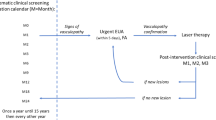Abstract
Purpose
To describe the clinical features and treatment outcomes of severe retinopathy in eyes with incontinentia pigmenti (IP) of infants within a few months of birth.
Study design
Retrospective clinical study.
Methods
Six eyes of three patients (6-day-old girl, 5-month-old girl, and 14-day-old boy) with IP were examined and treated under general anesthesia. Ophthalmologic examinations were performed including images from wide-angle fluorescein angiography (FA), swept-source optical coherence tomography (OCT), and OCT angiography (OCTA).
Results
Ophthalmoscopy showed prominent vascular tortuosity in five eyes, retinal hemorrhages in four eyes, and incomplete vascular development in two eyes. FA showed extensive avascularity including the posterior pole of the retina in all cases except one eye. Prompt and intensive laser photocoagulation stabilized the pre-proliferative severe retinopathy in five eyes; however, foveal structure and vessel anomalies were detected in three of six eyes by OCT and two of five eyes by OCTA.
Conclusion
Severe retinopathy in the neonatal period and infancy was present not only in the periphery but also in the posterior pole including the fovea, which might be related to retinal vascular maldevelopment. It is, therefore, recommended that wide-angle fundus FA examination be performed in the early postnatal period to detect early signs of severe retinopathy in infants with IP.




Similar content being viewed by others
References
Garrod AE. Peculiar pigmentation of the skin of an infant. Trans Clin Soc Lond. 1906;39:216.
Smahi A, Courtois G, Vabres P, Yamaoka S, Heuertz S, Munnich A, et al. Genomic rearrangement in NEMO impairs NF-kappaB activation and is a cause of incontinentia pigmenti. The International Incontinentia Pigmenti (IP) Consortium. Nature. 2000;405:466–77.
Goldberg MF, Custis PH. Retinal and other manifestations of incontinentia pigmenti (Bloch-Sulzberger syndrome). Ophthalmology. 1993;100:1645–54.
O’Doherty M, Mc Creery K, Green AJ, Tuwir I, Brosnahan D. Incontinentia pigmenti-ophthalmological observation of a series of cases and review of the literature. Br J Ophthalmol. 2011;95:11–6.
Swinney CC, Han DP, Karth PA. Incontinentia pigmenti: a comprehensive review and update. Ophthalmic Surg Lasers Imaging Retina. 2015;46:650–7.
Nishimura M, Oka Y, Takagi I, Yamana T, Kitano A. The clinical features and treatment of the retinopathy of Bloch-Sulzberger syndrome (incontinentia pigmenti). Jpn J Ophthalmol. 1980;24:310–9.
Ranchod TM, Trese MT. Regression of retinal neovascularization after laser photocoagulation in incontinentia pigmenti. Retina. 2010;30:708–9.
Meallet MA, Song J, Stout JT. An extreme case of retinal avascularity in a female neonate with incontinentia pigmenti. Retina. 2004;24:613–5.
Jandeck C, Kellner U, Foerster MH. Successful treatment of severe retinal vascular abnormalities in incontinentia pigmenti. Retina. 2004;24:631–3.
Chen CJ, Han IC, Tian J, Muñoz B, Goldberg MF. Extended follow-up of treated and untreated retinopathy in incontinentia pigmenti: analysis of peripheral vascular changes and incidence of retinal detachment. JAMA Ophthalmol. 2015;133:542–8.
Shah GK, Summers CG, Walsh AW, Neely KA. Optic nerve neovascularization in incontinentia pigmenti. Am J Ophthalmol. 1997;124:410–2.
Batioglu F, Ozmert E. Early indirect laser photocoagulation to induce regression of retinal vascular abnormalities in incontinentia pigmenti. Acta Ophthalmol. 2010;88:267–8.
An International Committee for the Classification of Retinopathy of Prematurity. The international classification of retinopathy of prematurity revisited. Arch Ophthalmol. 2005;123:991–9.
Yokoi T, Hiraoka M, Miyamoto M, Yokoi T, Kobayashi Y, Nishina S, et al. Vascular abnormalities in aggressive posterior retinopathy of prematurity detected by fluorescein angiography. Ophthalmology. 2009;116:1377–82.
Kenwrick S, Woffendin H, Jakins T, Shuttleworth SG, Mayer E, Greenhalgh L, et al. Survival of male patients with incontinentia pigmenti carrying a lethal mutation can be explained by somatic mosaicism or Klinefelter syndrome. Am J Hum Genet. 2001;69:1210–7.
Shaikh S, Trese MT, Archer SM. Fluorescein angiographic findings in incontinentia pigmenti. Retina. 2004;24:628–9.
DeVetten G, Ells A. Fluorescein angiographic findings in a male infant with incontinentia pigmenti. J AAPOS. 2007;11:511–2.
Lin KL, Hirose T, Kroll AJ, Lou PL, Ryan EA. Prospects for treatment of pediatric vitreoretinal diseases with vascular endothelial growth factor inhibition. Semin Ophthalmol. 2009;24:70–6.
Shah PK, Bachu S, Narendran V, Kalpana N, David J, Srinivas CR. Intravitreal bevacizumab for incontinentia pigmenti. J Pediatr Ophthalmol Strabismus. 2013;50:52–4.
Goldberg MF. Macular vasculopathy and its evolution in incontinentia pigmenti. Trans Am Ophthalmol Soc. 1998;96:55–65.
Basilius J, Young MP, Michaelis TC, Michaelis TC, Hobbs R, Jenkins G, et al. Structural abnormalities of the inner macula in incontinentia pigmenti. JAMA Ophthalmol. 2015;133:1067–72.
Mangalesh S, Chen X, Tran-Viet D, Viehland C, Freedman SF, Toth CA. Assessment of the retinal structure in children with incontinentia. Retina. 2017;37:1568–74.
Liu TYA, Han IC, Goldberg MF, Linz MO, Chen CJ, Scott AW. Multimodal retinal imaging in incontinentia pigmenti including optical coherence tomography angiography: findings from an older cohort with mild phenotype. JAMA Ophthalmol. 2018;136:467–72.
Acknowledgements
We thank the patients and their parents/guardians for participating in this study. This work was supported by grants from the National Center for Child Health and Development 28-2 and the Japan Agency for Medical Research and Development 19gk0110034h0002.
Author information
Authors and Affiliations
Corresponding author
Ethics declarations
Conflicts of interest
S. Nakao, None; S. Nishina, None; S. Tanaka, None; T. Yoshida, None; T. Yokoi, None; N. Azuma, None.
Additional information
Publisher's Note
Springer Nature remains neutral with regard to jurisdictional claims in published maps and institutional affiliations.
Corresponding Author: Noriyuki Azuma
Electronic supplementary material
Below is the link to the electronic supplementary material. Supplemental Fig.1a, 1b, 1c, 1d, 3a, 3b, 3c, 3d, 4a, 4b, 4c, 4c-2, 4d are provided to show the wide angle of views.
About this article
Cite this article
Nakao, S., Nishina, S., Tanaka, S. et al. Early laser photocoagulation for extensive retinal avascularity in infants with incontinentia pigmenti. Jpn J Ophthalmol 64, 613–620 (2020). https://doi.org/10.1007/s10384-020-00768-7
Received:
Accepted:
Published:
Issue Date:
DOI: https://doi.org/10.1007/s10384-020-00768-7




